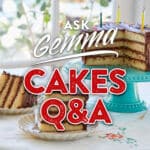
This post may contain affiliate links. Please see my full disclosure for details.
Hi Bold Bakers!
“Can wax paper go in the oven?” “Is wax paper the same as parchment paper?” “Is parchment the same as butcher paper?”
With all of the baking paper options out there it can be confusing which one to use and when. Read on to learn a bit more about 3 common types of kitchen paper and how they can help you!
Parchment Paper

Parchment paper is made by bathing sheets of paper pulp in either sulfuric acid or zinc chloride. These chemicals partially gelatinize the paper, rendering it oil, water and heat resistant up to 425°F (220°C) as well as making it non-stick. Some parchment paper is coated in silicone, making it even more non-stick and heat resistant up to 450°F (235°C). Although oven-safe, it isn’t fireproof and should never be used on a direct flame.

- In cooking and baking, it is used to line baking sheets and pans in place of butter and flour to prevent sticking, such as in my Aunty Rosaleen’s Traditional Irish Christmas Cake Recipe. Don’t forget to check out my easy, chef-tested tips on How to Line a Round Pan perfectly.
- It can also be used in place of flour on a work surface when rolling out sticky doughs and pastries.
- The French baking technique called “en papillote” uses the parchment paper that is folded to form a sealed bag around food to be roasted. As the food bakes, it releases moisture in the form of steam that is trapped by the parchment. This allows food to be gently steam-cooked without the need for fats or oils.
Wax Paper

Wax paper is thin tissue paper that has been triple coated in a food-grade paraffin wax. The wax is not heat resistant and should never be used for baking as it can smoke and also the wax can melt and get into your baked goods.
However, wax paper is very useful in certain applications:
- It creates a non-stick surface for rolling out sticky doughs and pastries, and it is also great for lining a work surface when decorating cookies or for resting cookies or other confections after dipping in chocolate.
- Wax paper can be used for individually wrapping sticky treats like marshmallows or caramels, such as my Pure Maple Candy.
- Also, it is more moisture resistant than parchment paper, making it the ideal choice to cover damp foods like chilled cheesecakes or custards.

Butcher Paper
Butcher paper is a thick paper made by processing kraft paper pulp with caustic soda, sulfide and sizing agents that make it moisture resistant. Its unique properties allow moisture retention in raw meats and fish but also allow some breathability to keep the meat fresh and prevent it from getting slimy.
Butcher paper is heat resistant up to 450°F (235°C) and can be used for cooking:
- It is popular for covering meats for long smoking as it allows the smoke in but keeps moisture from evaporating.
- It can also be used in the oven for lining baking sheets before roasting vegetables or meats. Its thicker texture makes it less ideal for more delicate baking like cookies or pastries.
Not only are all three of these papers important to any well-stocked kitchen, but these papers all have uses beyond the kitchen, for crafting and other projects. Have a look online – there is a wealth of creative information out there!







I’m a Brit who’s been living in South Africa for many years. I haven’t seen parchment paper in either place. Is it the same as what we call greaseproof paper?
Grreat write up. Thank you Gamma
My absolute favorite for delicious recipes and the science behind the bake. Thank you